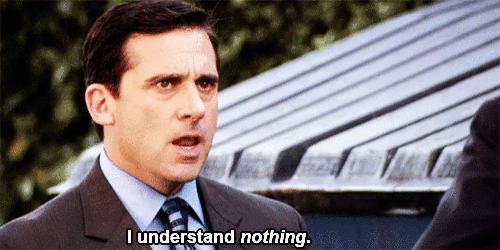THE IMPORTANCE OF ADMITTING YOU’RE WRONG
Hi my name is Erin and I don’t like to admit I’m wrong. I don’t think it’s necessarily anyone’s favorite thing to do but it can be really challenging for me because my stubborn, Type A personality doesn’t like the feeling of being wrong. Admitting you’ve changing your beliefs in the medical field can feel like you don’t know what you’re doing, further feeding into that Imposter Syndrome voice you have in the back of your head. Any maybe this means I’m not but being able to admit you’ve changed your mind is actually a sign of a great clinician.
Like most physical therapists, I decided to get into physical therapy because I was a patient myself. Back in high school I suffered from some patellar tendon pain and was in and out of therapy while playing sports. The main focus of my treatment was to activate and strengthen my VMO. I was told that my patella didn’t track correctly and strengthening my VMO would help to pull my patella back into alignment. I remember getting stim pads placed on my VMO and focusing on squeezing the muscle during exercises like quad sets and short arc quads. Eventually I did get better, but in hindsight I think my growing interest in weight lifting may have contributed more to my reduced symptoms than the quad sets.
By the time I got to grad school, the focus for treating knee pain became predominantly avoiding valgus. Valgus was the cause of knee pain, ACL tears, and a movement to avoid at all costs. Even though it’s a natural movement for the body, we were taught to limit it. We were shown videos of plyometrics with valgus collapse and athletes tearing their ACLs with non-contact cutting activities. This became a demonized idea and we were taught that it was not only bad, but should be eliminated. The solution was to strengthen the hips: stronger glutes and a focus of external rotation and abduction would solve knee pain and reduce the risk of ACL tears. You could walk into any physical therapy clinic and see patients performing clamshells and teams began incorporating band walks into their warm ups. ACL prevention programs popped up that focused on strengthening the hips and minimizing valgus. And because that’s how I was taught in school, that's how I treated patients. I focused on strengthening hip extension, abduction, and external rotation and cued patients to avoid valgus collapse when squatting, running, and jumping. I educated patients on the importance of avoiding valgus and told them that I could minimize the risk of them tearing their ACL by doing so. And that’s not to say what I did was inherently wrong, but could I have been doing more?
Recent evidence has shown that ACL tears are not a result of valgus collapse. An ACL tear occurs in 400th’s of a second (0.04), a time so fast that humans generally cannot comprehend that length of time let alone see the injury occur. Physical therapists have often placed their visual exam and manual skills above all other testing and treatment but let’s be honest, it’s far from reliable and there’s no chance we’re breaking down 400th’s of a second. Even if I don’t like admitting I’m wrong I can quickly tell you that my visual analysis of movement isn’t perfect and there’s no chance I can feel the sacrum moving.
Back to ACLs: the thought now is that the dynamic valgus that we can see actually occurs after the ACL is torn and that the injury mechanism is more in line with the function of the ACL, a forceful compression with sudden tibial anterior translation. Now I could write an entire article on the updated ACL evidence (shoot me a message if that’s something you’re interested in) but this article is focused on why you should be able to admit you’re wrong. Or at the very least admit that you’ve changed your mind.
I used to focus heavily on strengthening the hips to limit valgus and believed that I was helping to reduce the risk of ACL tears. Now what I did wasn’t necessarily bad: my patients got better, gained strength, and demonstrated improved movement quality. That’s still a win. However I did place a heavy emphasis on hip strengthening (since that’s what I was taught and that’s what I knew) but that left me with less time to focus on quad and hamstring strengthening. With proper mentorship, staying up to date on research, and my own clinical experience, I now place a much greater focus on all encompassing lower body strengthening, not just the hips. It’s easy for me to look back at how I was treating my patients with knee pain and cringe, thinking that I was a shit therapist and letting my intrusive thoughts take over. But what I should be focusing on is where I’m at now. It’s okay that I changed my mind and that I no longer agree with how I used to treat. It just means that I’m growing and learning and evolving, not that I was wrong at the time for doing it.
It is not a sign of weakness to admit that you’ve changed your mind or that you remain open to shifting your views. If you don’t you’ll become one of those dinosaur PTs who’s still focusing on activating the VMO to realign the patella or using therapeutic ultrasound. It’s easy to stay complacent with what you’ve already learned and it can be challenging to stay up to date with ever-changing research and search out proper mentorship. But what that does is make you a better clinician.
We’ve all seen the clinicians that become hyper fixated on a certain treatment technique, especially on social media. The knees over toes guy is going to tell you to let your knees go over your toes. Squat university is going to tell you to avoid valgus. Seedman is going to tell you to stay within 90 degrees. And they’re all correct. But that doesn’t mean they’re always correct. What it means is that bold, blanket, black-and-white statements sell really well on instagram. What doesn’t sell is “well maybe I was wrong” or “it depends” or “I’ve changed my mind” because it’s not flashy.
In the real world it always depends. And if you want to be a good clinician you need to be open to being wrong, open to changing your mind, and open to listening to others’ opinions. The easier route is to fall into complacency and do what you’ve always known. But instead I challenge you to be open to changing your mind. Stay up to date on research, follow accounts that make you question your views, find mentorship that challenges you, and don’t be afraid to change what you’ve been doing for years. Change your thought process from “I was wrong for doing it that way” to “I’m becoming a better clinician”.
And why not start now? Share something below that you’ve recently changed your mind on: it could help spark a conversation with a new grad or shift the perspective of an established therapist. There’s nothing worse than getting into a discussion with a practitioner who is so set in their ways that they refuse to listen to any other views so let’s work on being the practitioner who is happy to think critically and open to shifting their mindset. Thinking we know everything is where we truly go wrong and we can use this as an opportunity to learn from one another.
About The author: Erin Lynch
Follow Erin:
Instagram: @airun.kehlee.suhlevin
Email: elynch@therehabcode.com
Erin is the Creative Director for Rehab Code but if you read the article hopefully you realize she’s also a physical therapist, allowing her to bring a unique perspective to Rehab Code. She’s the face behind the curtain of all of the content you see and tends to prefer to keep things that way so you won’t necessarily find much rehab related content on her instagram. But if you want to see countless posts about her golden retriever, Dave, she’s your girl.












